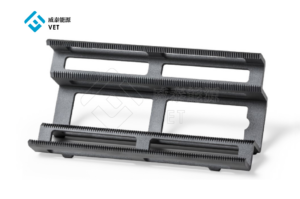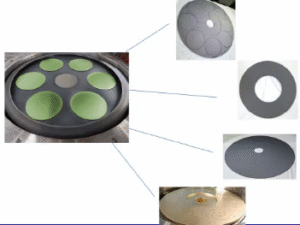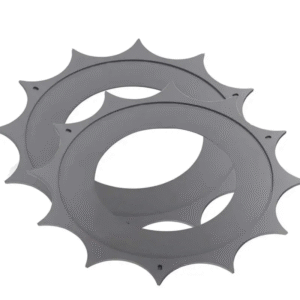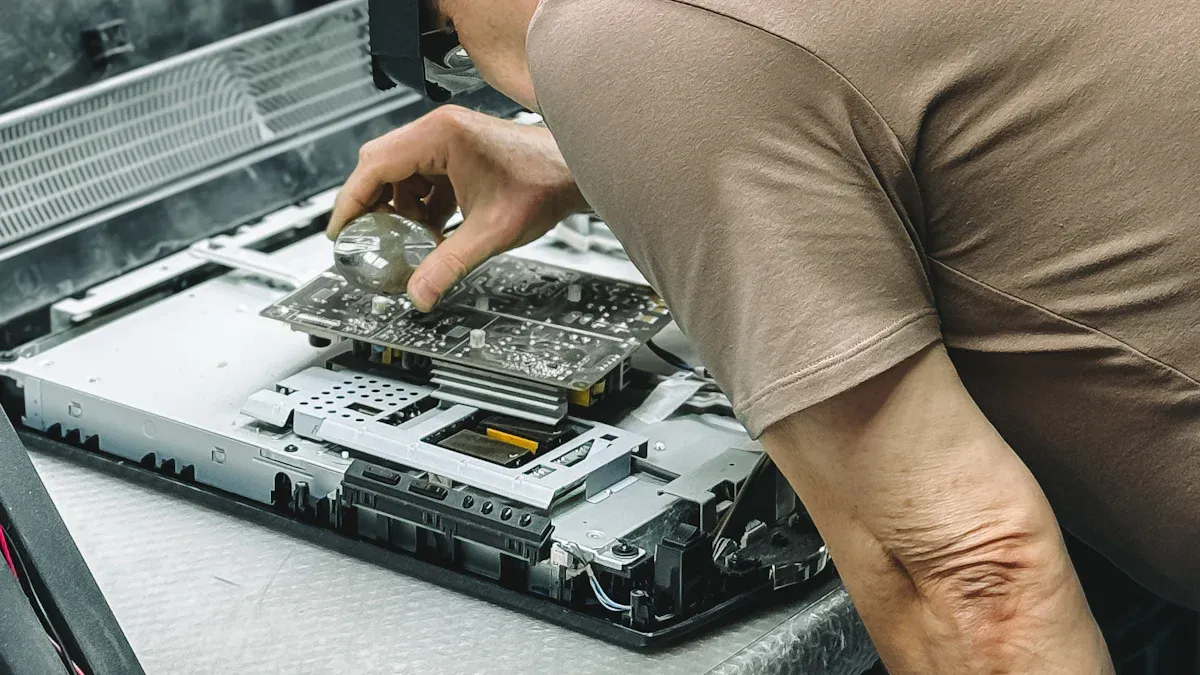
Advanced CVD SiC Coating solutions significantly enhance the durability of semiconductor fab equipment. These innovative SiC Coatings provide exceptional resistance to corrosion, effectively reducing contamination and extending operational lifespans. For example, SilcoTek’s technology enabled quenching sleeves to last over 70 days without degradation, far outperforming uncoated alternatives. This breakthrough minimizes downtime and replacement costs, offering a highly cost-effective solution. Ningbo VET Energy Technology Co., Ltd leads the industry by delivering premium solutions like TAC COATING and CVD SIC COATING, ensuring consistent performance and reliable protection for critical components.
Key Takeaways
- CVD SiC Coating helps semiconductor tools last longer by stopping rust and dirt.
- This coating lowers repair costs and machine breaks, saving money for fabs.
- Picking a trusted company, like Ningbo VET Energy Technology Co., Ltd, gives strong coatings made for your needs, improving tool work.
Understanding CVD SiC Coating
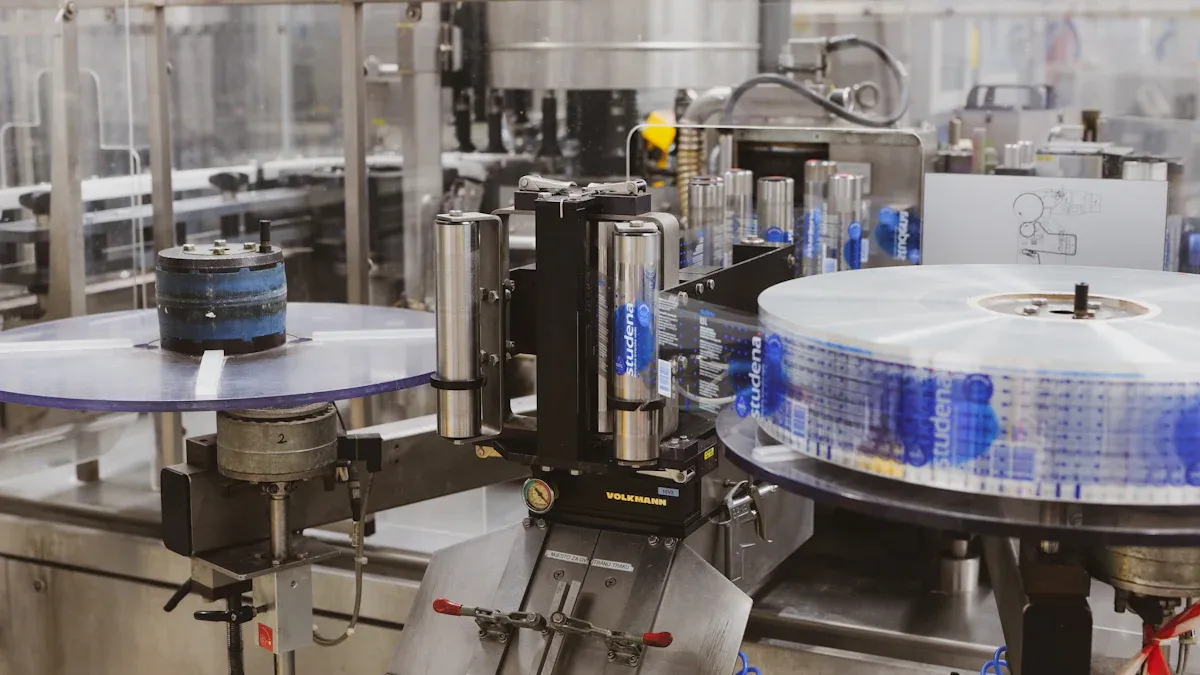
What is CVD SiC Coating?
CVD SiC Coating refers to a thin layer of silicon carbide applied to surfaces using the Chemical Vapor Deposition (CVD) process. This advanced coating method involves the reaction of gaseous precursors at high temperatures, resulting in a uniform and durable SiC layer. The coating enhances the performance of semiconductor fab equipment by providing superior protection against harsh operating conditions. Its ability to withstand extreme environments makes it a critical solution for modern semiconductor manufacturing.
Key Properties of CVD SiC Coating
CVD SiC Coating exhibits several unique properties that make it indispensable in semiconductor fabrication:
- Thermal Stability: It maintains structural integrity in high-temperature environments, ensuring reliable performance.
- Chemical Inertness: The coating resists reactions with corrosive gases, preserving the purity of semiconductor films.
- High Purity: Its composition minimizes impurity contamination, which is essential for high-performance semiconductor devices.
- Enhanced Interface Quality: The coating influences film-substrate interactions, improving growth modes and interface consistency.
Additionally, factors such as deposition temperature, gas composition, and precursor concentration significantly impact the coating’s microstructure and mechanical properties. These variables allow manufacturers to tailor the coating for specific applications.
Why CVD SiC Coating is Ideal for Semiconductor Fabs
Semiconductor fabs demand materials that can endure extreme conditions while maintaining precision. CVD SiC Coating meets these requirements by offering unmatched durability and resistance to wear. Its ability to reduce contamination ensures consistent product quality, while its thermal and chemical stability supports efficient operations. By extending the lifespan of critical components, this coating minimizes downtime and replacement costs, making it a cost-effective choice for fabs.
Ningbo VET Energy Technology Co., Ltd specializes in delivering high-quality CVD SiC Coating solutions tailored to the unique needs of semiconductor fabs. Their expertise ensures optimal performance and long-term reliability for advanced manufacturing processes.
Key Benefits of CVD SiC Coating
Enhanced Corrosion Resistance
CVD SiC Coating provides exceptional protection against corrosion, making it ideal for semiconductor fabs. Its chemical inertness prevents reactions with corrosive gases and liquids, ensuring the integrity of critical components. This resistance reduces the risk of equipment failure, especially in environments with aggressive chemicals. By safeguarding surfaces from degradation, the coating extends the operational lifespan of tools and machinery, enabling fabs to maintain high productivity levels.
Tip: Regular maintenance and inspections further enhance the corrosion resistance of coated equipment, ensuring long-term reliability.
Reduced Outgassing and Contamination
Semiconductor manufacturing demands ultra-clean environments to prevent contamination. CVD SiC Coating minimizes outgassing, a process where materials release volatile compounds that can compromise product quality. Its high purity and stable composition reduce the emission of impurities, ensuring cleanroom compatibility. This benefit is particularly crucial for processes like etching and deposition, where contamination can lead to defects in semiconductor devices. By maintaining a pristine environment, fabs achieve consistent yields and superior product performance.
Improved Durability and Consistent Performance
CVD SiC Coating enhances the durability of equipment by forming a robust protective layer. This layer withstands mechanical wear, thermal stress, and chemical exposure, ensuring consistent performance over time. Several factors contribute to its durability:
- Implementing rigorous quality control measures ensures flawless coating finishes.
- Understanding environmental factors like temperature and humidity leads to superior finishes.
- Proper surface preparation and regular inspections during application optimize adhesion and durability.
These practices result in equipment that performs reliably under demanding conditions, reducing downtime and maintenance costs.
Cost-Effectiveness and Long-Term Savings
Investing in CVD SiC Coating delivers significant cost savings for semiconductor fabs. By extending the lifespan of equipment, the coating reduces the frequency of replacements and repairs. Its ability to minimize contamination and maintain consistent performance also lowers operational costs associated with defective products and process interruptions. Over time, these benefits translate into substantial financial savings, making CVD SiC Coating a cost-effective solution for fabs aiming to optimize their operations.
Ningbo VET Energy Technology Co., Ltd offers advanced CVD SiC Coating solutions that combine durability, purity, and cost-efficiency. Their expertise ensures fabs achieve long-term savings while maintaining high-quality manufacturing standards.
Applications of CVD SiC Coating in Semiconductor Fabs
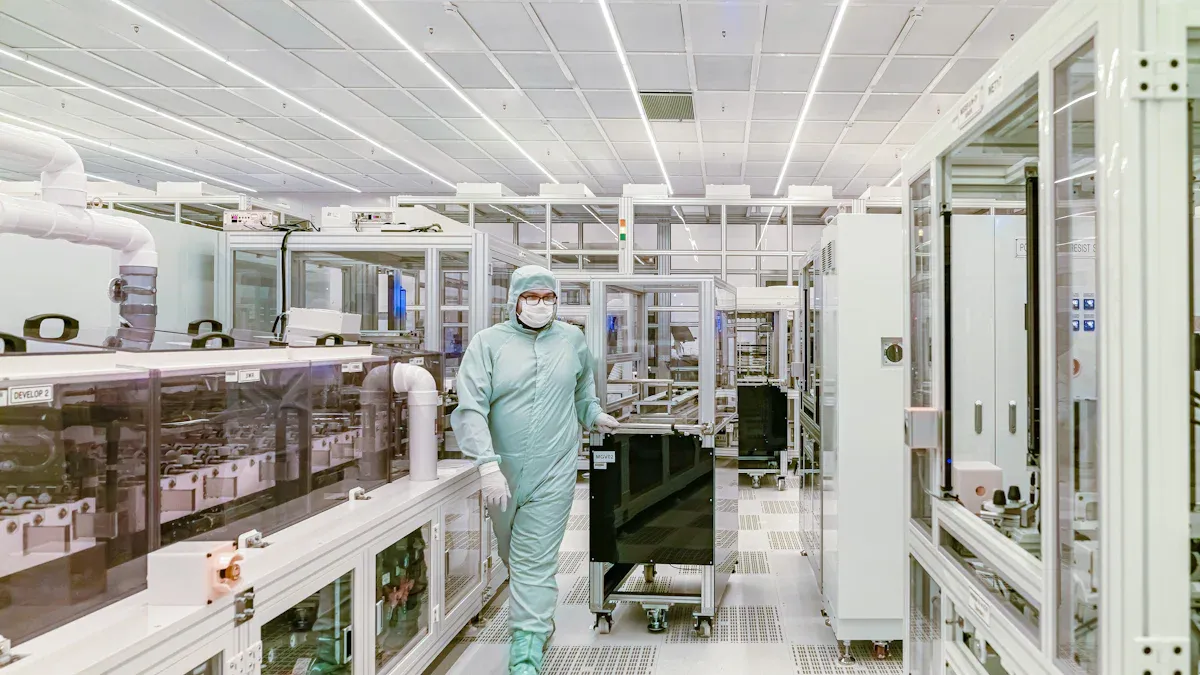
Use in Cleanroom Environments
Cleanrooms in semiconductor fabs demand ultra-clean surfaces to prevent contamination during manufacturing. CVD SiC coating plays a pivotal role in maintaining these pristine conditions. Its chemical inertness and low outgassing properties ensure that volatile compounds do not compromise the cleanroom environment. This coating also resists particle generation, which is critical for processes requiring high precision.
A comparison of cleanroom performance metrics highlights the advantages of CVD SiC-coated susceptors over traditional materials like graphite or quartz:
| Performance Metrics | CVD SiC Coated Susceptors | Traditional Materials (Graphite/Quartz) |
|---|---|---|
| Thermal Stability | Superior | Good/Excellent |
| Chemical Resistance | Excellent | Poor/Limited |
| Durability | Enhanced | Susceptible to degradation |
| Heat Distribution | Improved | Varies |
| Risk of Defects | Reduced | Higher |
By offering superior thermal stability and chemical resistance, CVD SiC coating ensures cleanroom compatibility and supports defect-free production.
Applications in Process Gas Delivery Systems
Process gas delivery systems in semiconductor fabs operate under extreme conditions, including exposure to corrosive gases and high temperatures. CVD SiC coating enhances the performance of these systems by providing a robust barrier against chemical reactions. This coating prevents corrosion and ensures the purity of gases delivered to critical processes.
Key benefits include:
- Improved system longevity: The coating reduces wear and tear, extending the lifespan of components.
- Enhanced gas purity: Its chemical inertness minimizes contamination risks, ensuring consistent process quality.
- Reduced maintenance: The durable coating lowers the frequency of repairs and replacements, optimizing operational efficiency.
These advantages make CVD SiC coating indispensable for maintaining the reliability of gas delivery systems in semiconductor fabs.
Role in Etching and Deposition Equipment
Etching and deposition processes are fundamental to semiconductor manufacturing. These processes often involve aggressive chemicals and high temperatures, which can degrade unprotected equipment. CVD SiC coating provides a protective layer that withstands these harsh conditions, ensuring consistent performance.
Applications in etching and deposition equipment include:
- Chamber components: The coating protects surfaces from chemical erosion, maintaining the integrity of the equipment.
- Wafer carriers: Its thermal stability ensures uniform heat distribution, critical for precise deposition.
- Plasma-facing parts: The coating resists plasma-induced damage, reducing downtime and maintenance costs.
By safeguarding equipment, CVD SiC coating supports high-quality semiconductor production and minimizes operational disruptions.
Protection of Graphite Components Against Erosion and Contamination
Graphite components are widely used in semiconductor fabs due to their thermal conductivity and machinability. However, they are prone to erosion and contamination in harsh environments. CVD SiC coating addresses these challenges by forming a protective barrier on graphite surfaces.
This coating offers:
- Erosion resistance: It prevents material loss caused by chemical reactions or mechanical wear.
- Contamination control: The coating’s high purity reduces the risk of impurities affecting semiconductor devices.
- Extended component lifespan: By minimizing degradation, the coating reduces the need for frequent replacements.
These benefits make CVD SiC coating a cost-effective solution for protecting graphite components in semiconductor fabs.
Note: Ningbo VET Energy Technology Co., Ltd specializes in providing advanced CVD SiC coating solutions tailored to these applications. Their expertise ensures optimal performance and long-term reliability for semiconductor manufacturing equipment.
Practical Strategies for Implementing CVD SiC Coating
Cost Considerations for Adopting CVD SiC Coatings
Adopting CVD SiC Coating requires careful financial planning. Initial investments for establishing production facilities can range from $30 to $50 million. Regulatory compliance adds further complexity, with costs between $1.2 and $1.8 million, potentially delaying market entry by up to two years. Supply chain challenges also impact costs, as new manufacturers face lead times of 6 to 9 months for certified raw materials. Established suppliers, however, benefit from long-term contracts that stabilize expenses.
| Evidence Type | Details |
|---|---|
| Capital Requirements | Establishing a minimum viable production facility for automotive-grade SiC coatings demands $30-$50 million in initial investments. |
| Operational Complexity | Regulatory compliance costs range from $1.2-$1.8 million and can delay market entry by 18-24 months. |
| Supply Chain Challenges | New manufacturers face 6-9 month lead times for certified raw materials, while established players benefit from long-term contracts. |
| Certification Timelines | Automotive Tier 1 suppliers require 18-month qualification processes, impacting production capacity and margins. |
Understanding these factors helps fabs allocate resources effectively and plan for long-term savings.
Ensuring Compatibility with Existing Equipment
Compatibility with existing equipment is critical when implementing CVD SiC Coating. Manufacturers must evaluate the substrate materials and operating conditions of their tools. Coating thickness, thermal expansion properties, and adhesion strength should align with the equipment’s specifications. Conducting pilot tests ensures seamless integration and prevents operational disruptions.
Selecting the Right Vendor for CVD SiC Coating Solutions
Choosing a reliable vendor ensures the success of CVD SiC Coating implementation. Key factors include the vendor’s experience, quality control processes, and ability to customize coatings for specific applications. Vendors with a proven track record in semiconductor fabs, like Ningbo VET Energy Technology Co., Ltd, offer tailored solutions that meet industry standards.
How Ningbo VET Energy Technology Co., Ltd Supports Implementation
Ningbo VET Energy Technology Co., Ltd provides end-to-end support for implementing CVD SiC Coating. Their expertise includes material selection, process optimization, and quality assurance. By leveraging advanced technologies, they deliver coatings that enhance equipment performance and longevity. Their commitment to customer satisfaction ensures seamless adoption and long-term reliability for fabs.
CVD SiC Coating offers transformative benefits for semiconductor fabs. Its ability to enhance durability, reduce contamination, and deliver long-term cost savings makes it indispensable for optimizing operations. For instance, advanced SiC variants demonstrate 18% higher thermal conductivity and 40% greater fracture toughness, ensuring superior performance in demanding applications like 5G electronics. Additionally, coatings with defect densities below 0.5 defects/cm² are prioritized for extreme-environment electronics, highlighting their critical role in maintaining product quality.
Adopting advanced coatings not only extends equipment lifespan but also reduces operational disruptions, enabling fabs to achieve consistent yields. Ningbo VET Energy Technology Co., Ltd stands out as a trusted partner, offering tailored solutions that meet the rigorous demands of modern semiconductor manufacturing. Their expertise ensures fabs can leverage cutting-edge technologies to remain competitive in a rapidly evolving industry.
FAQ
What makes CVD SiC coating superior to traditional coatings?
CVD SiC coating offers unmatched thermal stability, chemical resistance, and durability. These properties ensure longer equipment lifespan and reduced contamination in semiconductor manufacturing environments.
How does Ningbo VET Energy Technology Co., Ltd ensure coating quality?
Ningbo VET Energy Technology Co., Ltd employs advanced technologies and rigorous quality control processes. Their expertise guarantees high-performance coatings tailored to semiconductor fab requirements.
Can CVD SiC coating be applied to all semiconductor fab equipment?
CVD SiC coating is compatible with most equipment. However, manufacturers should evaluate substrate materials and operating conditions to ensure optimal adhesion and performance.
Tip: Consult experts like Ningbo VET Energy Technology Co., Ltd for tailored solutions and seamless implementation.


